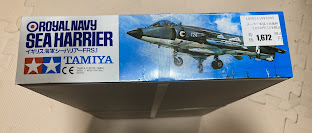Tamiya 1/48 Royal Navy Sea Harrier FRS.1.
This is an interesting one. Apparently this is a bad model representation. That in itself with Tamiya must be unusual. For me as a rank ameteur I don't see it and so I enjoyed building this as I love the Harrier in all it's forms.
The question I ask is... If you have a lot of knowledge about the models you build, does that actually spoil your enjoyment of the hobby?
Love to know your thoughts...
As I said, I love the Harrier so I love the image.
The British Aerospace Sea Harrier is a naval short take-off and vertical landing/vertical take-off and landing jet fighter, reconnaissance and attack aircraft. It is the second member of the Harrier family developed. It first entered service with the Royal Navy in April 1980 as the Sea Harrier FRS1 and became informally known as the "Shar". Unusual in an era in which most naval and land-based air superiority fighters were large and supersonic, the principal role of the subsonic Sea Harrier was to provide air defence for Royal Navy task groups centred around the aircraft carriers.
Image of one of the icluded schemes on the long side. You can actually leave a panel off to see the engine but I'm not sure that it's detailed enough as it stands to make it worthwhile. One for you scratch builders but if the comments on the overall accuracy is valid...
More information on the other long side. How's your Japanese?
Usual purchasing info on the end panels... Just over ten dollars. Good value? How about eight pounds?
One of these days, I might do a stealth version...
The Sea Harrier served in the Falklands War and the Balkans conflicts; on all occasions it mainly operated from aircraft carriers positioned within the conflict zone. Its usage in the Falklands War was its most high profile and important success, when it was the only fixed-wing fighter available to protect the British Task Force. The Sea Harriers shot down 20 enemy aircraft during the conflict; 2 Sea Harriers were lost to enemy ground fire. They were also used to launch ground attacks in the same manner as the Harriers operated by the Royal Air Force.
Let's check the box out.
A Harrier don't you know.
It is an old model tooling from 1971. Maybe we should keep that in mind as we go...I mean, all in all I think it's fine. 1971 is a while back. Things have moved on since.
The fuselage...
Wings and ordinance.
Engine and peripherals.
Decals and canopy.
One more time with the canopy.

The usual Tamiya paperwork along with the Japanese and English language versions.
Some good info in the instructions.
Choose your colour scheme. Sea grey or sea grey? Perhaps if you are American sea 'gray'...
Time to build stuff.
The Sea Harrier is a subsonic aircraft designed for strike, reconnaissance and fighter roles. It features a single Rolls-Royce Pegasus turbofan engine with two intakes and four vectorable nozzles. It has two landing gear on the fuselage and two outrigger landing gears on the wings. The Sea Harrier is equipped with four wing and three fuselage pylons for carrying weapons and external fuel tanks.The use of the ski jump allowed the aircraft to take off from a short flight deck with a heavier payload than would otherwise be possible, although it can also take off like a conventional loaded fighter without thrust vectoring from a normal airport runway.
The Sea Harrier's cockpit includes a conventional centre stick arrangement and left-hand throttle. In addition to normal flight controls, the Harrier has a lever for controlling the direction of the four vectorable nozzles. The nozzles point rearward with the lever in the forward position for horizontal flight. With the lever back, the nozzles point downward for vertical takeoff or landing. The utility of the vertical landing capability of the Sea Harrier was demonstrated in an incident on 6 June 1983, when Sub Lieutenant Ian Watson lost contact with the aircraft carrier HMS Illustrious and had to land Sea Harrier ZA176 on the foredeck of the Spanish cargo ship Alraigo.
Probably the worst case of fitting I have had since the resumption...
Lots of Tamiya putty and many many sanding...
Time for the sea gray upper sides and the gloss black nose.
As you can imagine the white underside took more than one coat...
Adding the pylons at this stage too.
Weathering covers a multitude of sins... Especially for us brush painters. Arms length viewing...

Adding the stores ...
The Sea Harrier was largely based on the Harrier GR3, but was modified to have a raised cockpit with a "bubble" canopy for greater visibility and an extended forward fuselage to accommodate the Ferranti Blue Fox radar. Parts were changed to use corrosion resistant alloys, or coatings were added, to protect against the marine environment. After the Falklands War, the Sea Harrier was fitted with the Sea Eagle anti-ship missile.
On with the canopy...
Adding the decals and we are done. It was perfectly fine. I enjoyed the model. I love the harrier. What else could I ask for?
What do you think. Can you ignore the failings of a model and just enjoy building it?
Is a little knowledfdge a dangerous thing?
























































Comments
Post a Comment